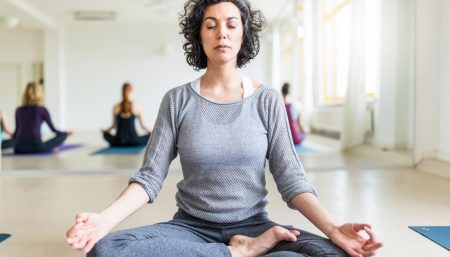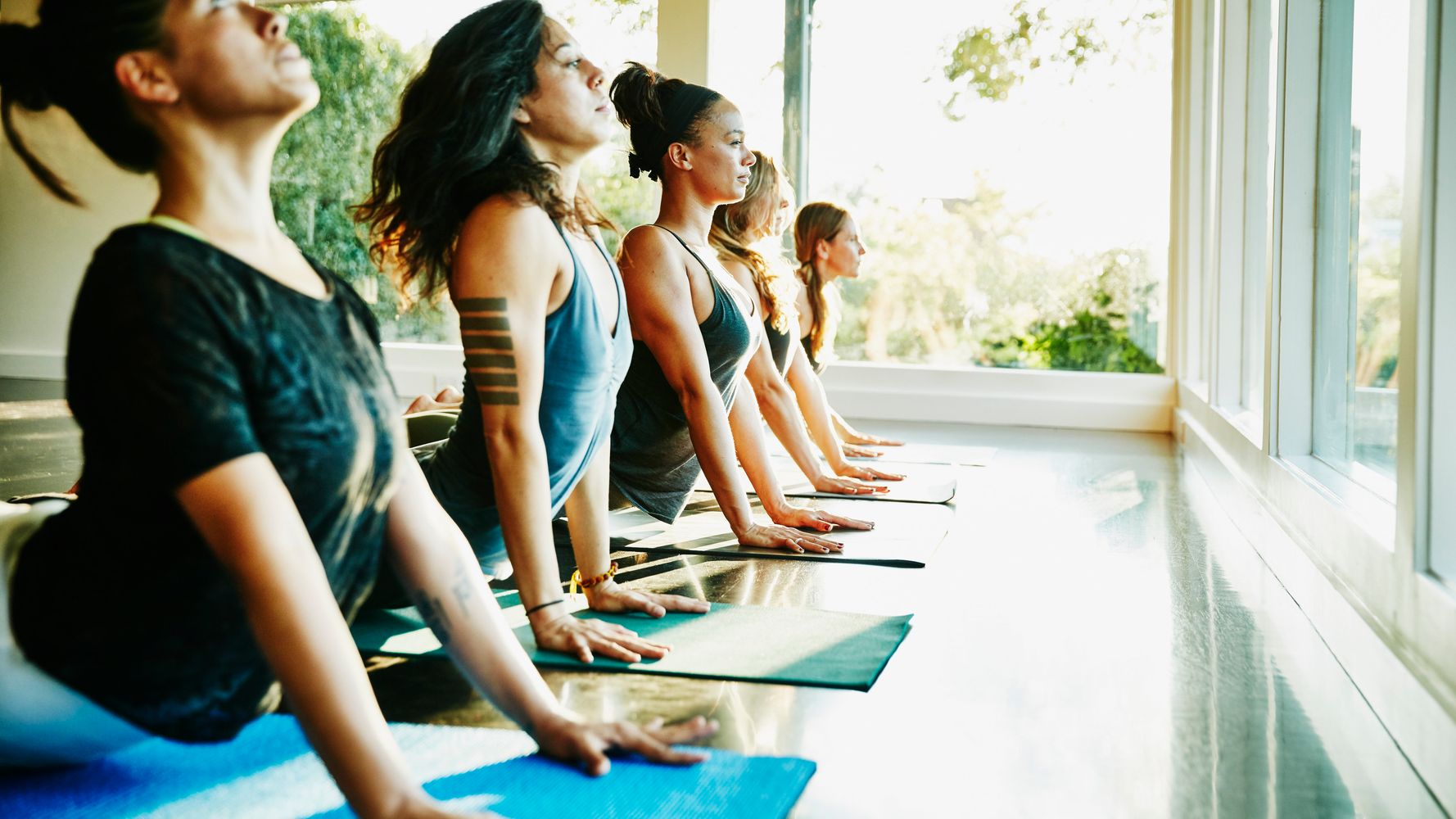
If you’re a woman in your 40’s or early 50’s, you’re probably experiencing some degree of peri-menopause symptoms- one of them being, low sex drive. Having problem with remaining focused, might leave sex boring or unemotional.
One study reported that, after completing a 12-week program that included about an hour of yoga each day, women reported improvements in desire, arousal, orgasm, and other good stuff relating to sexual function. This article brings you some excellent yoga poses to increase your sexual appetite. Do them solo or, even better, with your partner (sweating, breathing, and moving together is fantastic foreplay).
| The pelvic organs and the muscles supporting them, particularly the perineal muscles (located between the anus and the genitals) and the pelvic floor are toned, oxygenated, and flushed with fresh blood and nutrients while practicing yoga. This can contribute to greater sensitivity and responsiveness during intercourse. |
Sex Poses
![]() Adho Mukha Svanasana (Downward Facing Dog): “a great pre-sex pose”
Adho Mukha Svanasana (Downward Facing Dog): “a great pre-sex pose”
- Begin on your hands and knees. Your wrists should be underneath your shoulders, and your knees underneath your hips.
- Inhale as you tuck your toes under your heels. Then exhale to lift your hips, coming into an upside down “V” shape called Downward Facing Dog.
- Spread your fingers wide and create a straight line between your middle fingers and elbows. Work on straightening your legs and lowering your heels toward the ground. Your heels should be slightly wider than your toes, so the outside edges of your feet are parallel with the outside edges of your mat. Relax your head between your arms, and direct your gaze through your legs or up toward your belly button. Work on holding for five breaths.
![]() Plank Pose: for a sizzling session
Plank Pose: for a sizzling session
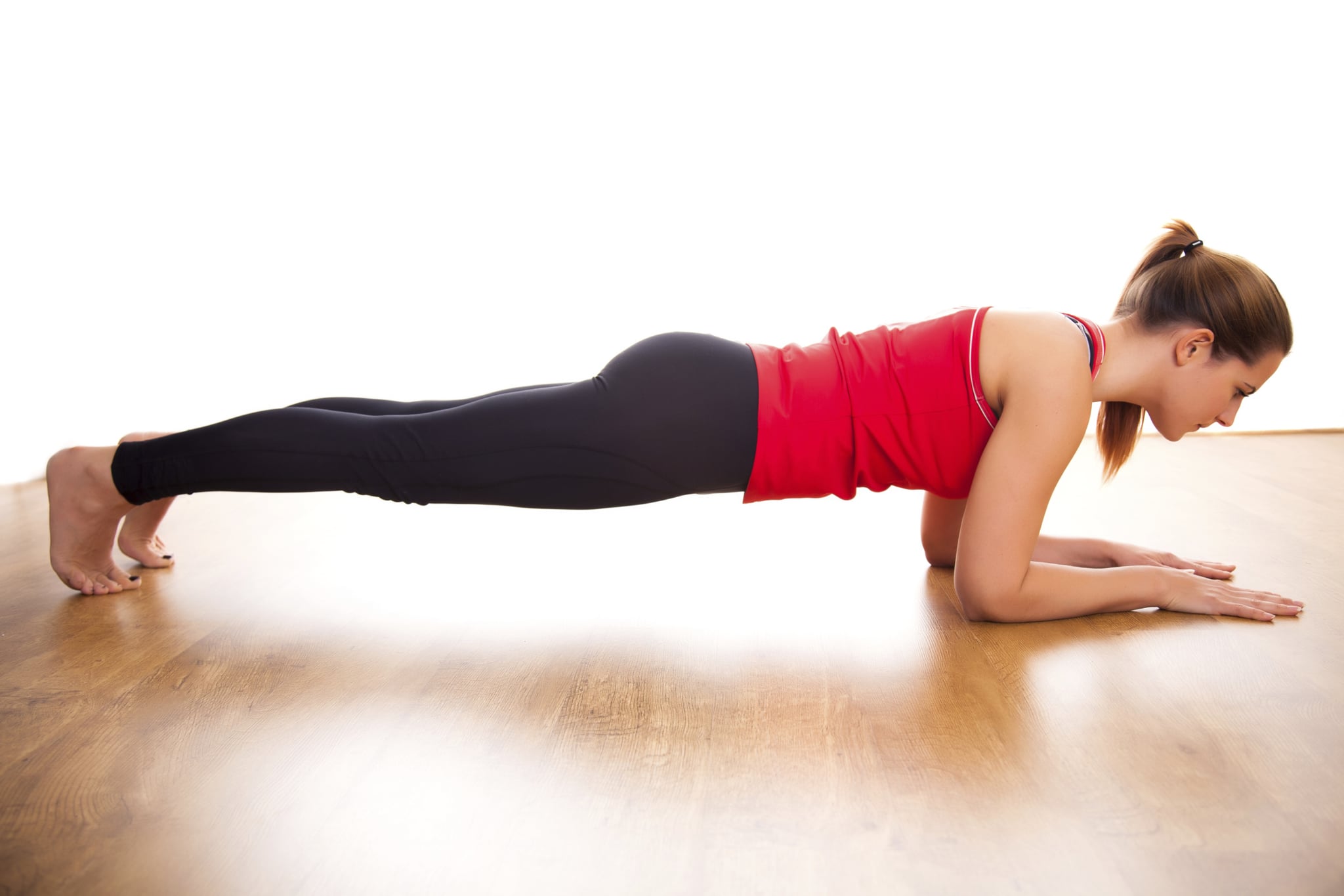
- Start in Adho Mukha Svanasana. Then inhale and draw your torso forward until the arms are perpendicular to the floor and the shoulders directly over the wrists, torso parallel to the floor.
- Press your outer arms inward and firm the bases of your index fingers into the floor. Firm your shoulder blades against your back, then spread them away from the spine. Also spread your collarbones away from the sternum.
- Press your front thighs up toward the ceiling, but resist your tailbone toward the floor as you lengthen it toward the heels. Lift the base of the skull away from the back of the neck and look straight down at the floor, keeping the throat and eyes soft.
- Plank Pose is one of the positions in the traditional Sun Salutation sequence. You can also perform this pose by itself and stay anywhere from 30 seconds to 1 minute.
![]() Kapotasana ( Pigeon Pose)
Kapotasana ( Pigeon Pose)
- From Downward Facing Dog, step both feet together and bring your right knee forward between your hands, such that your outer right leg is resting on the mat.
- Drop your back leg to the ground. Keep the back leg turned under.
- Keeping your front leg bent, place it shin down on floor behind your right wrist.
- Align your right knee straight in front of your right hip and your right shin parallel to the front of your mat.
- Lower your hips, bringing your left knee to the floor and walk your left foot back a few inches to straighten your left leg directly behind your left hip. Rest the top of your left foot on the floor.
- Walk your fingertips out to 18 inches in front of your right shin and bring your elbows to the floor, forearms parallel to each other.
- Draw your right hip back, and your left hip forward
- Take quite a few breaths in Pigeon (3-7 breath) . Make sure your front foot is well flexed. You may feel this pose in your hips as they open up.
![]() Balasana (Child Pose)
Balasana (Child Pose)
- Kneel on the floor, and then sit directly onto your heels.
- Shift your knees until they are a little more than hip-width apart.
- Bend forward at the hip; bring your chest to rest between your thighs.
- Keep your buttocks in contact with your heels and rest your forehead on the floor. If this is uncomfortable, rest your forehead on a cushion or folded blanket-make sure it is high enough for you to be comfortable.
- Stretch your arms out in front of you on either side of your head. Lengthen the muscles as far as you can, really give a good stretch! Then slide your arms back to your sides, palms up and relax.
- Remain in this pose for as long as possible. Breathe deeply and relax into the posture.
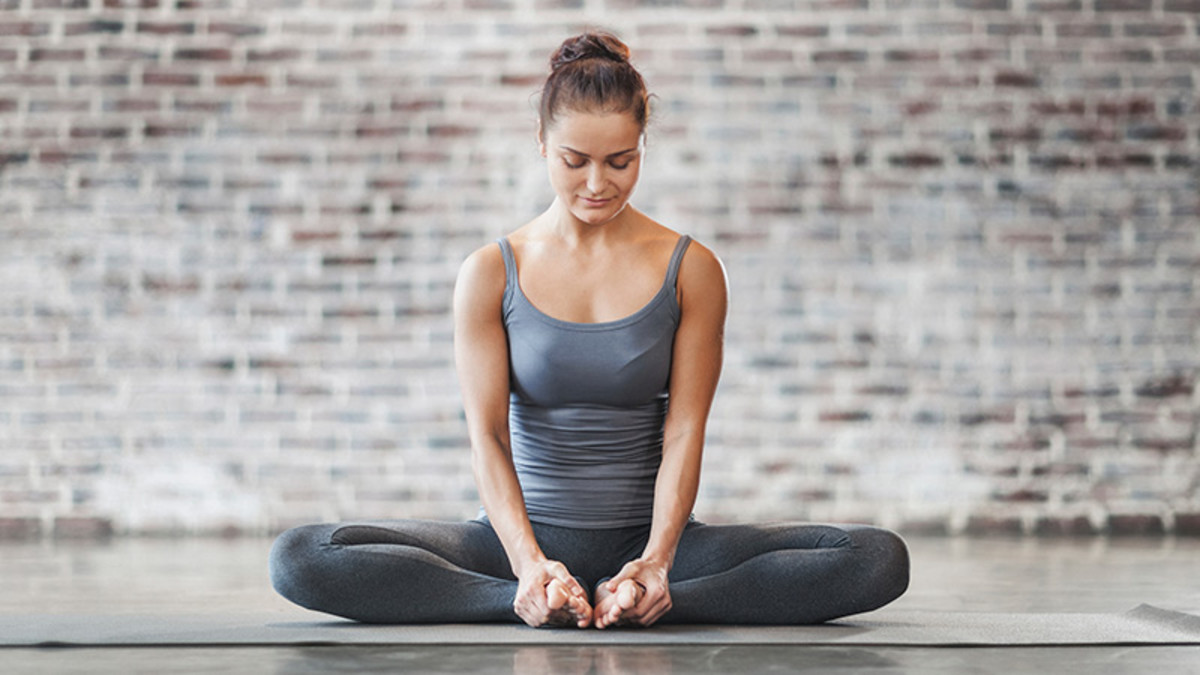
![]() Baddha Konasana (Bound Angle): heat up the groin.
Baddha Konasana (Bound Angle): heat up the groin.
- Sit with your legs straight out in front of you, raising your pelvis on a blanket if your hips or groins are tight. Exhale, bend your knees, pull your heels toward your pelvis, then drop your knees out to the sides and press the soles of your feet together.
- Bring your heels as close to your pelvis as you comfortably can. With the first and second finger and thumb, grasp the big toe of each foot. Always keep the outer edges of the feet firmly on the floor. If it isn’t possible to hold the toes, clasp each hand around the same-side ankle or shin.
- Sit so that the pubis in front and the tailbone in back are equidistant from the floor. The perineum then will be approximately parallel to the floor and the pelvis in a neutral position. Firm the sacrum and shoulder blades against the back and lengthen the front torso through the top of the sternum.
- Never force your knees down. Instead release the heads of the thigh bones toward the floor. When this action leads, the knees follow.
- Stay in this pose anywhere from 1 to 5 minutes. Then inhale, lift your knees away from the floor, and extend the legs back to their original position.
![]() Marjariasana (Cat Stretch)
Marjariasana (Cat Stretch)
- Come onto your fours. Form a table such that your back forms the table top and your hands and feet form the legs of the table.
- Keep your arms perpendicular to the floor, with the hands directly under the shoulders and flat on the ground; your knees are hip-width apart.
- Look straight ahead.
- As you inhale, raise your chin and tilt your head back, push your navel downwards and raise your tailbone. Compress your buttocks.
- Hold the Cat pose and take long, deep breaths.
- Follow this by a countermovement: As you exhale, drop your chin to your chest and arch your back up as much as you can; relax the buttocks.
Hold this pose for a few seconds before you return to the initial table-like stage. - Continue five or six rounds before you come out of this yoga posture.
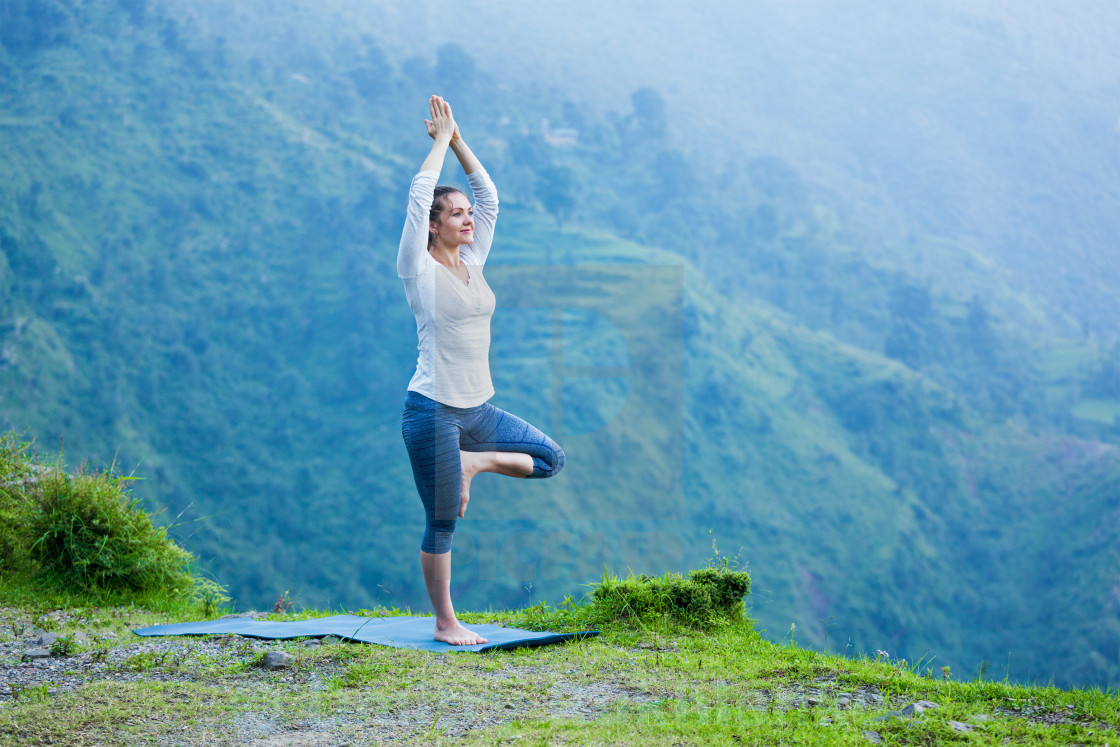
Vrikshasana (Tree pose): Regular practice of this posture will help focus the mind and cultivate concentration (dharana).
- Stand with the feet together and the arms by your sides (see the tad-asana.)
- Bend the right leg at the knee, raise the right thigh and bring the sole of the right foot as high up the inside of the left thigh as possible.
- Balancing on the left foot, raise both arms over the head keeping the elbows unbent and joining the palms together.
- Hold the posture while breathing gently through the nostrils for about 10 complete breaths.
- Lower the arms and right leg and return to the tad-asana, standing position with feet together and arms at the sides.
- Pause for a few moments and repeat on the opposite leg.
![]() Setubandha asana (Bridge pose): get ready for action!
Setubandha asana (Bridge pose): get ready for action!
- Lie supine on the floor, and if necessary, place a thickly folded blanket under your shoulders to protect your neck. Bend your knees and set your feet on the floor, heels as close to the sitting bones as possible.
- Exhale and, pressing your inner feet and arms actively into the floor, push your tailbone upward toward the pubis, firming (but not hardening) the buttocks, and lift the buttocks off the floor. Keep your thighs and inner feet parallel. Clasp the hands below your pelvis and extend through the arms to help you stay on the tops of your shoulders.
- Lift your buttocks until the thighs are about parallel to the floor. Keep your knees directly over the heels, but push them forward, away from the hips, and lengthen the tailbone toward the backs of the knees. Lift the pubis toward the navel.
- Lift your chin slightly away from the sternum and, firming the shoulder blades against your back, press the top of the sternum toward the chin. Firm the outer arms, broaden the shoulder blades, and try to lift the space between them at the base of the neck (where it’s resting on the blanket) up into the torso.
- Stay in the pose anywhere from 30 seconds to 1 minute. Release with an exhalation, rolling the spine slowly down onto the floor.
![]() Sarvangasana (Shoulder-stand)
Sarvangasana (Shoulder-stand)
- To start with, lie flat on the floor. The arms should rest along the sides, palms downwards. Exhale once, bend the knees, and bring them up towards the chin till the thighs press the stomach. Breathe normally.
- Now, exhale and supporting the buttocks with the hands, raise the trunk till it becomes perpendicular to the floor. Now, your body will be supported by the back of the head, the neck, the shoulders and the backs of the arms up to the elbows. To push the trunk into the vertical position, you will need to gradually move the hands towards the waist. The head continues to rest on the floor, so that the trunk also becomes perpendicular to the head. Once it is correctly perpendicular, the chin will touch the chest.
- Now, raise the legs and make them vertical, in line with the trunk, with the toes pointing upwards. Breathe evenly, calmly and easily. Stay in the pose for a few minutes and feel the good it is doing you.
- To release the pose, gently move the legs downwards, release the hands and let the body become flat again. You may also bring the legs down so that the knees approach the ears, and then gradually bring the legs down. Be gentle on your body. Never apply excessive stress. To start with, practice the initial position, drawing the knees towards the chin.
Release the pose gently.
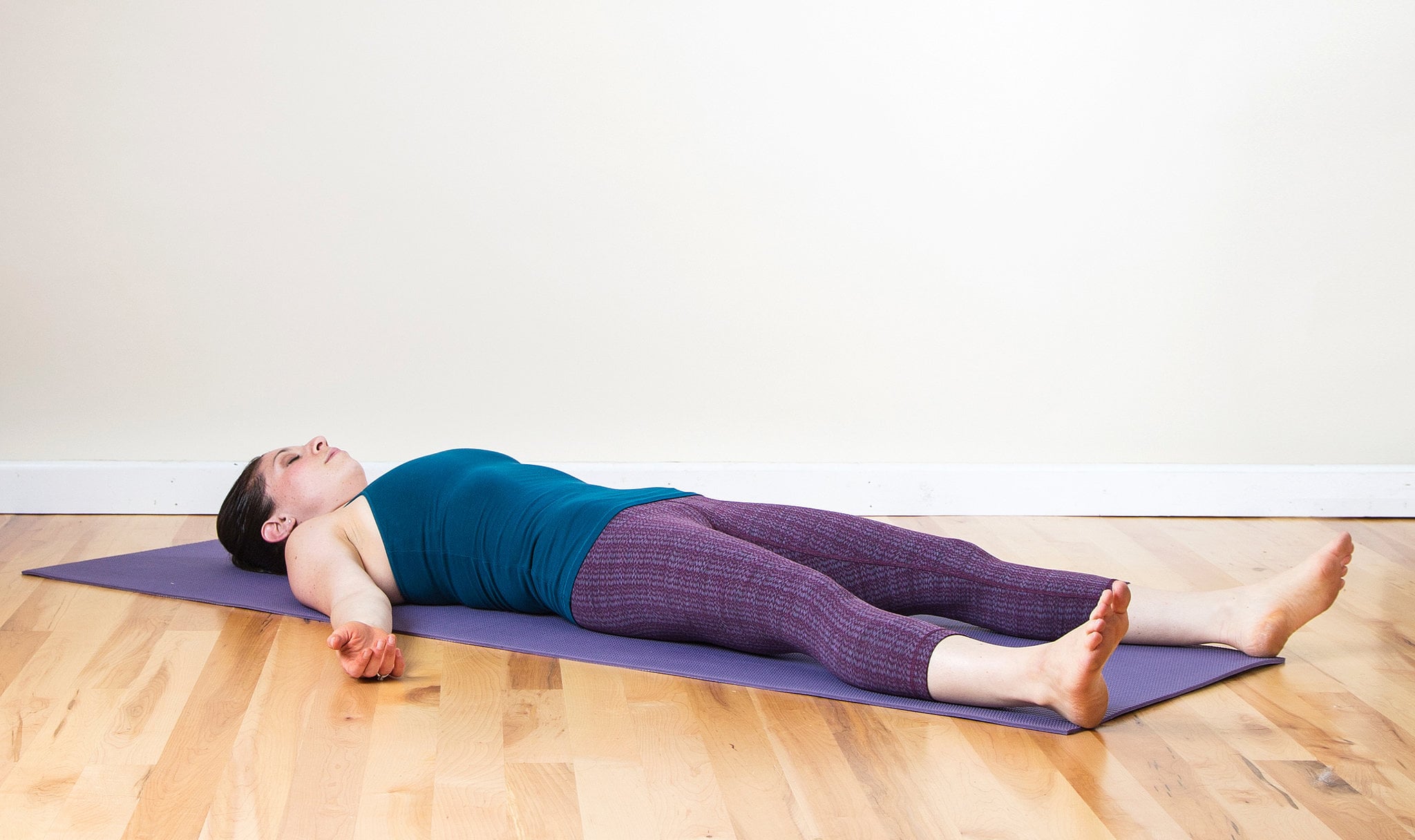
![]() Savasana (Corpse pose): a must before and after sex.
Savasana (Corpse pose): a must before and after sex.
- Sit on the floor with your knees bent, feet on the floor, and lean back onto your forearms. Lift your pelvis slightly off the floor and, with your hands, push the back of the pelvis toward the tailbone, then return the pelvis to the floor. Inhale and slowly extend the right leg, then the left, pushing through the heels. Release both legs, softening the groins, and see that the legs are angled evenly relative to the mid-line of the torso, and that the feet turn out equally. Narrow the front pelvis and soften (but don’t flatten) the lower back.
- With your hands lift the base of the skull away from the back of the neck and release the back of the neck down toward the tailbone. If you have any difficulty doing this, support the back of the head and neck on a folded blanket. Broaden the base of the skull too, and lift the crease of the neck diagonally into the center of the head. Make sure your ears are equidistant from your shoulders.
- Reach your arms toward the ceiling, perpendicular to the floor. Rock slightly from side to side and broaden the back ribs and the shoulder blades away from the spine. Then release the arms to the floor, angled evenly relative to the mid-line of torso. Turn the arms outward and stretch them away from the space between the shoulder blades. Rest the backs of the hands on the floor as close as you comfortably can to the index finger knuckles. Make sure the shoulder blades are resting evenly on the floor. Imagine the lower tips of the shoulder blades are lifting diagonally into your back toward the top of the sternum. From here, spread the collarbones.
- In addition to quieting the physical body in Savasana, it’s also necessary to pacify the sense organs. Soften the root of the tongue, the wings of the nose, the channels of the inner ears, and the skin of the forehead, especially around the bridge of the nose between the eyebrows. Let the eyes sink to the back of the head, then turn them downward to gaze at the heart. Release your brain to the back of the head.
- Stay in this pose for 5 minutes for every 30 minutes of practice. To exit, first roll gently with an exhalation onto one side, preferably the right. Take 2 or 3 breaths. With another exhalation press your hands against the floor and lift your torso, dragging your head slowly after. The head should always come up last.
You can do these yoga poses as a workout routine, or just try your favorites whenever you want to get in the mood!
Disclaimer
The Content is not intended to be a substitute for professional medical advice, diagnosis, or treatment. Always seek the advice of your physician or other qualified health provider with any questions you may have regarding a medical condition.

